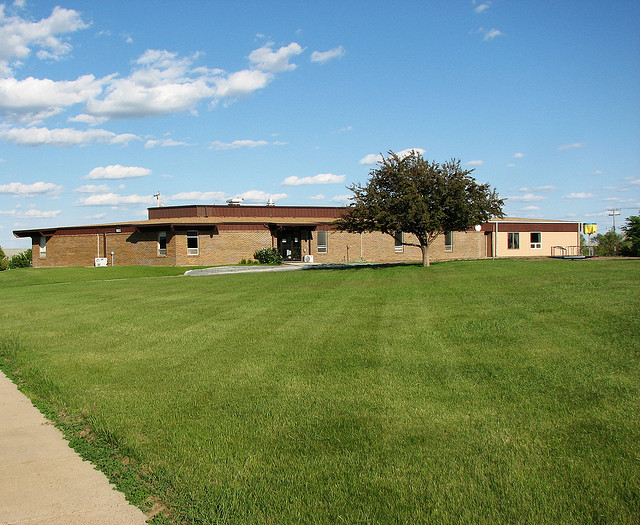Beach
Beach is named for Captain Warren Beach of the Eleventh Infantry, who accompanied the Stanley railroad survey expedition here in 1873. It is the county seat of Golden Valley County.
Beach showed little growth in early years. It was just a small mark in the landscape, and until the Land Survey settled the question, no one was sure if it was in North Dakota or Montana.
About 1901 government engineers began working on the U.S. Land Survey, which had to be completed before homesteading could begin. The engineers lived in tents pitched near the railroad's section house.
It was at that time Beach growth began to take off. There was a grocery store, a "blind pig" saloon, a hotel, a church, an eating house, general merchandise store, a ladies' emporium, and a post office. Homesteaders were beginning to arrive. Before the days of the Beach train depot, the contents of their immigrant cars were piled beside the tracks until they could be hauled out to hastily erected tents or tar paper homes. To care for these peoples' needs, stores and businesses of all kinds became necessary.
Beach became a village in 1907 and incorporated into a city in 1909. When Golden Valley County was organized in 1912, Beach became temporary county seat by appointment and retained the position in the following general election.
A decade early in the century, 1905-1915, was the boom time for Beach. Telephones and electric lights arrived. The town pump was replaced by a deep well system. Elementary and high schools were built. A long line of grain elevators, referred to as 'prairie skyscrapers,' replaced the box cars. Beach was known as the world's largest primary grain market. The town had grown to include seven churches. During the next decade, 1915-1925, community growth declined. For whatever reason, the Beach Boom was over, and the city settled into a slower, easier pace.
Today, Beach is booming again with a strong agricultural economy and energy development throughout western North Dakota. The need for new residential and commercial properties has created opportunities for the community to grow.
Golva
The origins of the t own of Golva, North Dakota go back to 1913, but once the railroad came through the area in 1915, development began. Built with horses, mules and wagons, the railroad was completed in 1916.
own of Golva, North Dakota go back to 1913, but once the railroad came through the area in 1915, development began. Built with horses, mules and wagons, the railroad was completed in 1916.
Golva is located in Lone Tree Township, within Golden Valley County, North Dakota. When the town was platted, it was intended to serve as the county seat, which never occurred. Golva's name was derived from the first three letters of "Golden" and the first two letters of "Valley", a name that was suggested by the original town site owner, A.L. Martin.
Prior to 1915, most of the local businesses were in Burkey, about four miles southwest of Golva. Saint Mary's Catholic Church was moved from Burkey to Golva in 1920, where it served until it was torn down in 1968, and replaced by a new building. In 1920, the Equity Elevator burned, and the Farmers Elevator was built in its place. The business community of Golva once included a hardware store, grocery store, car dealership, lumberyard, two grain elevators, two bars, a few restaurants, and several other businesses. Currently, there are still two elevators in Golva, along with a lumberyard, gas station, bank, grocery store, and a church.
The Golva, North Dakota post office was established in 1916. Golva's first school was a one-room country school house, which was replaced by a larger, brick building in 1917, to which a new addition was added in 1971. Golva High School and Golva Elementary School were in the same building from 1920 to 1972, when a new elementary school was constructed next to the high school. However, the high school was closed in 1989, and eventually dismantled due to low enrollment. The Golva Public School now serves about twenty-five students in grades K-8th grade. Golva students in grades nine through twelve are transported to Beach, North Dakota.
Never a large town, businesses did well in Golva until the Great Depression, when many business people had to sell out and move on. Golva never fully recovered.
Currently, the population of Golva is under one hundred, but it is still a vibrant community. Referring to their home as the "Biggest Little Town on the Prairie", townspeople host a 4th of July celebration each year, with a picnic, dance, and fireworks display that brings hundreds of people to Golva, many of them former residents.
Sentinel Butte
In 1880 the railroad reached Sentinel Butte and a mile beyond. Until 1885 Sentinel Butte was regarded as the territorial dividing line, and the railroad builders believed they had reached the Dakota-Montana border. Sentinel Butte was not a townsite until 1902.
From 1906-1910 Sentinel Butte became a booming metropolis. Settlers arrived during that time to take advantage of the free homestead land or to invest in railroad land. The city boasted nearly 800 residents and about 40 businesses. It was a business mecca, but the prosperity was short lived.
The 160-acre homesteads and low western North Dakota yields were not enough to provide a good family living on so few acres. Several years of drought left many homesteaders broke. Their credit gone, they had to leave. The growth of nearby Golva and Beach took from Sentinel Butte businesses. One after another, the businesses began to fold.
The population of Sentinel Butte is now only about 50, but it hasn’t diminished in character or charm. Olson’s Service Station is the only business facility in city limits; however several artisans and craftsmen reside in Sentinel Butte.
Southeast of the city stands a flat-topped butte, Square Butte. An irregular two-crested butte north of the city is known as Camel’s Hump, with a small fishing lake at its base.
The highest point, and the best known perch for a bird’s-eye view of Golden Valley County is Sentinel Butte, the second highest point in North Dakota. The Sentinel Butte region abounds in moss agates of reported large sizes. The trail to the top of the butte can be driven by automobile, and once atop the butte, a half acre of level grounds affords the visitor the pleasure of exploring the beauty of the area. On the butte, look closely and you will find an Indian “Kindling the Camp Fire,” carving done by former County Agent J. Clayton Russell. There is also the markings of the grave of one of the sentinels on Sentinel Butte.
Old Highway 10 from Beach to Medora is a pleasurable slow-paced drive that takes travelers through Sentinel Butte. The beauty of the area, with abundant wildlife and foliage, and the beauty of the golden fields of wheat provide a relaxed view of this welcoming western North Dakota area.
Several years of drought left many homesteaders broke. Their credit gone, they had to leave. The growth of nearby Golva and Beach took from Sentinel Butte businesses. One after another, the businesses began to fold.
